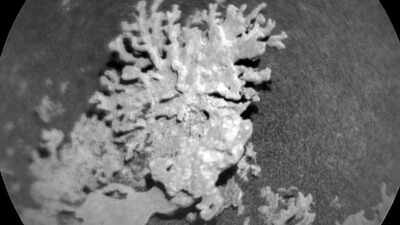ARTICLE AD BOX

In a new image sent from Mars, NASA’s Curiosity rover has captured something that immediately caught scientists’ attention– a small, oddly shaped rock that closely resembles coral.
According to a report by NASA, the image was taken on July 24, 2025, during the rover’s 4,609th day on the Martian surface.At first glance, it may seem like a curious shape. But behind this formation lies a much older and more detailed story– one that stretches back billions of years to a time when Mars was a very different place.Ancient water and wind: The forces that shaped itAccording to the NASA report, this type of structure is the result of a common geological process.
In the distant past, when liquid water still existed on Mars, it seeped into cracks in rocks. That water carried dissolved minerals, which settled into the cracks and stayed behind once the water dried up.
Over time, the surrounding rock, which was less resistant, was worn away by continuous wind erosion– leaving the mineral deposits exposed in unusual shapes. These formations, while shaped by natural forces, are often visually complex and have been compared to floral or marine structures found on Earth, as per the NASA report.
Close-up Captured by ChemCamAccording to the report, the image of the coral-like rock was taken using the Remote Micro Imager (RMI), a component of the ChemCam instrument aboard Curiosity. ChemCam plays a key role in helping scientists study the composition and texture of rocks from a distance.Around the same period, another rock with a similar form was observed using Curiosity’s Mars Hand Lens Imager, adding more detail to this ongoing study of Martian geology.According to the NASA report, the ChemCam itself is the result of an international partnership– developed by the U.S. Department of Energy’s Los Alamos National Laboratory, in collaboration with the French space agency CNES, the University of Toulouse, and CNRS.A mission that keeps deliveringCuriosity, which landed on Mars in 2012, continues to operate from NASA’s Jet Propulsion Laboratory in California. The rover is part of NASA’s Mars Science Laboratory project and operates under the broader Mars Exploration Program, led by the agency’s Science Mission Directorate in Washington.Not just an odd shapeWhile the rock’s shape has drawn interest due to its resemblance to coral, the real significance lies in what it tells us about Mars. Formations like these offer evidence that water once played an active role in shaping the Martian surface.Wind, minerals, and erosion have combined over billions of years to create the landscapes that Curiosity continues to explore today. This latest find is another reminder of how much Mars has changed– and how much there is still to understand.Thumb image: X/@astrobiobuzz



.png)
.png)
.png)
















 2 hours ago
5
2 hours ago
5









 English (US) ·
English (US) ·